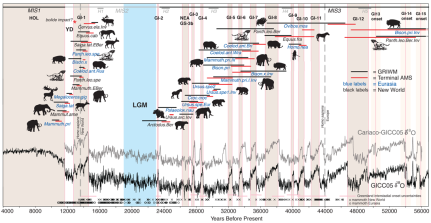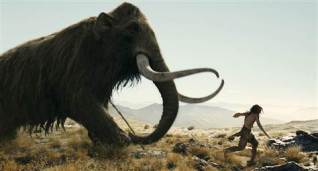Did ice ages cause the Pleistocene megafauna to go extinct? Contrary to popular opinion, no, they didn’t. But climate change did have something to do with them, only it was global warming events instead.
Just out today in Science, our long-time-coming (9 years in total if you count the time from the original idea to today) paper ‘Abrupt warmings drove Late Pleistocene Holarctic megafaunal turnover‘ demonstrates for the first time that abrupt warming periods over the last 60,000 years were at least partially responsible for the collapse of the megafauna in Eurasia and North America.
You might recall that I’ve been a bit sceptical of claims that climate changes had much to do with megafauna extinctions during the Late Pleistocene and early Holocene, mainly because of the overwhelming evidence that humans had a big part to play in their demise (surprise, surprise). What I’ve rejected though isn’t so much that climate had nothing to do with the extinctions; rather, I took issue with claims that climate change was the dominant driver. I’ve also had problems with blanket claims that it was ‘always this’ or ‘always that’, when the complexity of biogeography and community dynamics means that it was most assuredly more complicated than most people think.
I’m happy to say that our latest paper indeed demonstrates the complexity of megafauna extinctions, and that it took a heap of fairly complex datasets and analyses to demonstrate. Not only were the data varied – the combination of scientists involved was just as eclectic, with ancient DNA specialists, palaeo-climatologists and ecological modellers (including yours truly) assembled to make sense of the complicated story that the data ultimately revealed.
So why did it take so long? I think because we used data from vastly different disciplines to create the most comprehensive evidence of what happened in the Holarctic during the last 60,000 years, editors and reviewers couldn’t get their heads around it all very easily. Perseverance and myriad checks and double-checks though have eventually convinced the publishing powers that it deserves to see the light of day.
So this is what we did. We first assembled the most comprehensive database of paleontological and ancient DNA (aDNA) evidence from as many ‘megafauna’ (> 40 kg) species that we could gather. We needed reasonable time series of dated fossil or aDNA specimens, which is a minimum to determine extinction (or appearance) events because of the problem of the Signor-Lipps effect. Also, the aDNA evidence was essential to increase the resolution of things like major population and clade changes not detectable from fossil evidence alone. We then applied our Signor-Lipps corrections, and finally we had a decent set of 31 major megafauna transitions with which to work.
The next step was to compile the most precise record of Holarctic palaeo-climate variation ever undertaken – we did this by using the tried-and-tested Greenland ice core dataset, but then corrected some of the major transitions using the Cariaco (Venezuela) marine sediment record to construct a more precise record of the major warming (interstadials) and cold (stadials) events over the last 60,000 years.
 Finally, with this detailed history of extinction and transition events and climatology (see above figure), we had to determine whether the relationship between them was non-random. We had originally expected that there might be a relationship with the chronology of the cold (stadial) events (I actually didn’t expect any climate signal at all), but a randomisation approach that I designed showed exactly the opposite! No, it wasn’t the cold events (check out the almost complete absence of events from the Last Glacial Maximum – LGM), but there was a definitive relationship with the warm (interstadials) instead! Holy shit!
Finally, with this detailed history of extinction and transition events and climatology (see above figure), we had to determine whether the relationship between them was non-random. We had originally expected that there might be a relationship with the chronology of the cold (stadial) events (I actually didn’t expect any climate signal at all), but a randomisation approach that I designed showed exactly the opposite! No, it wasn’t the cold events (check out the almost complete absence of events from the Last Glacial Maximum – LGM), but there was a definitive relationship with the warm (interstadials) instead! Holy shit!
This means that rapid warming periods were correlated with a higher-than-expected rate of extinction and/or transition, but it doesn’t say anything about the contribution of humans. To do that, we had to test different combinations of events relative to the appearance of humans (around 44,000 years ago in Eurasia and 14,000 years ago in North America) to tease the effects apart. There is no question that humans had a role, but there’s also no question that rapid global warming also contributed.
What this means for the future of large species on this planet is sobering. Yes, we have long suspected that global climate disruption and the subsequent warming would be bad for wildlife, but now we have definitive, empirical proof that the synergy of human over-hunting and global warming can lead to catastrophic extinction events. We told you so.
I think Blue Sky Studios might have to rewrite some of their best-known franchises.




[…] Professor Bradshaw offers additional reflections on this paper at his blog ConservationBytes. […]
LikeLike
[…] one who has studied the megafauna extinctions in the Holarctic, Australia and South America over the last 50,000 years, the trip to Kruger was like stepping back […]
LikeLike
[…] back into what the Pleistocene must have been like in Australia, Europe, and North and South America, I’m moved to near tears by the truly awesome1 megafauna that still exists […]
LikeLike
[…] several hundred thousand years of the great human expansion. In some places, you find evidence of some climatic signal, and in others, none at […]
LikeLike
[…] July I wrote about a Science paper of ours demonstrating that there was a climate-change signal in the overall […]
LikeLike
Good to be reminded that homosapiens have at least been consistent!
Sadly gratifying to have your research bear out the truth of what many of us have feared – the combination of human ‘takes’ (and that can be any means of removing an individual from a population – bycatch, over-hunting, whatever) and global warming can lead to catastrophic extinction events.
LikeLike
[…] 1. Conservationbytes has summarised a study that found abrupt warming periods over the last 60,000 years were at least partially responsible for the collapse of the megafauna in Eurasia and North America. ‘No, it wasn’t the cold events (check out the almost complete absence of events from the Last Glacial Maximum – LGM), but there was a definitive relationship with the warm (interstadials) instead!’ […]
LikeLike